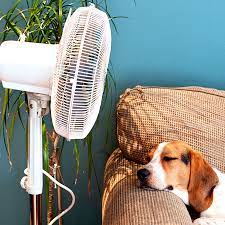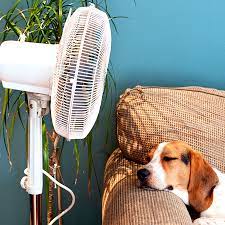Blog
Keeping Your Pets Cool in the Heat


Keeping Your Dogs and Cats Cool and Safe During Hot Weather
By Jeffrey Richard, Jameson Humane Volunteer
The lazy, hazy days of summer – when we and our pets enjoy more time outdoors – will soon be arriving. So now is the time to raise awareness of how we can protect our cats and dogs from harm that may result from exposure to heat and sunshine.
Heat Exhaustion and Heatstroke
The condition known broadly as heat exhaustion (aka hyperthermia) occurs when your pet’s body temperature rises above a healthy range, accompanied by various harmful symptoms. The seriousness of heat exhaustion ranges from mild heat exhaustion (which can sometimes be treated adequately at home) to heatstroke, depending on the severity of the pet’s fever and the dehydration that may accompany it. Heatstroke poses a serious threat to your pet’s health, and may result in organ failure, brain damage and even death. Immediate treatment by a veterinarian is essential. Please seek advice and treatment from your veterinarian whenever you observe signs of heat exhaustion in your pet. Do not rely on this article (or any article) as a substitute for veterinary aid!
With dogs, any temperature above 103 degrees is abnormal and may indicate heat exhaustion. The more severe condition, heatstroke, occurs in dogs when body temperature exceeds 106 degrees. With cats, look out for a temperature above 102.5 degrees; anything above 104 degrees may mean heatstroke.
Many people are unaware of the impacts of heat on pets. In particular, many pet owners are not aware of the real danger to their pets when left in unventilated cars or other confined spaces. Even on a comparatively cool day of, say, 70 degrees, the air temperature inside a car – if exposed to the sun without adequate ventilation – will rise to 115 degrees or more within an hour. Please never leave your pet unattended in a closed vehicle.
Heat Exhaustion and Heatstroke in Cats
Although heat exhaustion and heatstroke affect dogs more than cats because dogs are left in cars and other confined spaces more often, cats can and do suffer heat-induced trauma. Cats are not as physiologically well-equipped as people to regulate their body temperature. The human body produces perspiration that cools the body when the weather heats up. Cats cannot sweat to cool down, and (unlike dogs, who use panting as a way to regulate body temperature to some extent) they don't normally pant until they are already heat-exhausted.
Instead, cats instinctively move to cooler locations as soon as they feel too warm. They also engage in self-grooming (licking), which helps them stay cool to a limited extent. Most of the time, they are able to cool themselves or escape the heat before they approach heat exhaustion. However, a cat may become trapped in a hot area (e.g., a garage or shed) and fall victim to heat exhaustion.
Kittens, senior cats and sick cats are more vulnerable because they are less able to take steps on their own to avoid the heat. In addition, short-nosed cats like Persians and Himalayans often have constricted airways and are more sensitive to heat. Cats who are overweight are also more prone to overheating. For all of these higher risk kitties, it is especially important to make sure they stay in places that won’t get too hot.
Here are some of the more common indications of heatstroke in cats:
- Body temperature of 104 degrees or more (less severe heat exhaustion may be indicated by a temperature between 102.5 and 103.5 degrees)
- Rapid breathing, panting, or respiratory distress
- Anxiety or restlessness
- Dizziness and/or disorientation
- Dark red gums and tongue
- Rapid heartbeat
- Drooling with thick saliva due to dehydration
- Tremors or seizures
Heat Exhaustion and Heatstroke in Dogs
As with cat breeds, any canine breed with a short or flat nose is at an increased risk for heatstroke. The more constricted structure of the nasal passages limits their ability to breathe efficiently (and to pant as a way to cool off). Examples include English bulldogs, French bulldogs, pugs, and Shih Tzus. Here are common symptoms of heat exhaustion and heatstroke in dogs (which, as you’ll see are similar in a number of respects to feline symptoms):
- Body temperature of 106 degrees or more (less severe heat exhaustion may be indicated by a temperature between 103 and 105.5 degrees)
- Excessive panting or difficulty breathing. If your dog is panting constantly or faster than normal (hyperventilation), they could be overheated
- Signs of dehydration, which may include bright red, gray, purple, or bluish gums, dry nose, visible tiredness, and sunken eyes
- Excessive drooling. Keep an eye out for lots of drool, or drool that is thicker and stickier than usual
- Lack of normal urine production
- Rapid pulse. The easiest way to take your dog’s pulse is to place your hand on their chest near their front elbow joint. If their pulse seems elevated, they could be overheated. (Normal pulse rate depends on the size of your dog—bigger dogs tend to have slower pulses, while small dogs and puppies have very quick pulses)
- Muscle tremors, shivering or shaking
- Lethargy or weakness
- Vomiting or diarrhea
- Abnormally soft stool, or stool with blood in it
- If your dog seems to have trouble walking in a straight line or keeps bumping into furniture, they might be lightheaded from dehydration or heat exhaustion
Prevention and Treatment
To prevent heat exhaustion and to take steps to lessen the impacts of heat exhaustion if it occurs, there are a few things to keep in mind. Do not shave off your pet’s fur. Although reasonable and normal trimming of the coats of some dogs is fine, never shave the dog’s fur off entirely to keep it cool. The coats of both cats and dogs shield them not only from cold weather but also from the heat of summer. For all pets, including those that spend some of their time outdoors, provide access to cool indoor areas and provide cool, fresh water at all times. Make sure to leave the air conditioner or fan on when you are not home. Before running the clothes dryer, always check to make sure your cat has not snuck inside.
If you observe symptoms of heat exhaustion:
- Take your pet to a veterinarian as soon as possible if you have any doubt about whether the heat exhaustion is mild enough to be treated at home
- If the pet is alert, offer cool water to drink but do not force it. Many animals resist drinking water when they are overheated. If your pet refuses to drink, use an eyedropper or syringe to drop a couple of beads of water in its mouth at a time
- Use cool/tepid water to soak a towel and place your pet on it if possible. Do not wrap your pet in the towel as this may trap heat. Change the towel out when it becomes warm from your pet's body heat
- Note: Use of ice or cold water may be counterproductive and harmful. Ice or very cold water may constrict the blood vessels and prevent cooling, or may even cause hypothermia
- Turn on a fan or air conditioner if possible
- Continue to check your pet’s temperature. Stop cooling methods once the body temperature falls below dangerous levels. Excessive cooling at this stage increases the risk of hypothermia
Sunburn
The ASPCA has published a good online article about the risk of sunburn to your pets. See, https://www.aspcapetinsurance.com/resources/sun-safety-concerns-for-dogs-and-cats/ The following are some key excerpts:
“Pets without hair, like the Sphynx cat or Mexican hairless dog, are certainly at risk for getting a sunburn. But any pet can get burned in areas that have no or minimal fur, including the tips of the ears, lips, and mid-section. For instance, pets who like to sunbathe on their backs can end up with a burned belly. Other pets who are more prone to sunburn include those who have thin or light-colored coats or suffer from health conditions that cause hair loss, such as allergies or Cushing’s disease. Additionally, if your pet has been shaved for surgery, you should be extra careful about their sun exposure. You may also be surprised to know that indoor cats are at risk for sunburn. Regular windows do not filter out harmful UV rays so cats who like to nap in windowsills or snooze in sunbeams can get sunburnt. Cats with white or beige coats tend to have lighter colored skin, which can burn more easily.”
“Treatment: While a minor case of sunburn will generally heal on its own, you should bring your pet to the veterinarian if the burn is red and painful. They can assess the severity of the burn and recommend the appropriate treatment. This will usually involve shaving the affected area, carefully cleaning the burn, and applying a topical ointment. You may need to apply the ointment at home as well. . . ."
“Prevention: The best way to prevent sunburn is to keep your pet out of the sun as much as possible, especially when it is at its hottest. Of course, this doesn’t mean you shouldn’t go outside with your pet, but you can take steps to keep them safe from sunburn:
- Use a pet-safe sunscreen on exposed areas of skin . . .
- Have your pet wear clothing designed to provide sun protection
- Take walks in the early mornings or late evenings when the sun isn’t as strong
- Stick to shadier routes when you’re out with your pet
“If your pet is getting sunburned by basking near a window or sliding glass door, you can look into installing solar shades, which block harmful UV rays."
“A veterinary-approved sunscreen is recommended to help protect areas prone to sunburns, such as your pet’s belly and the tips of the ears. Avoid using human sunscreen products, since they can contain harmful ingredients that may irritate your pet’s skin or make your pet sick if they lick it off. Ask your veterinarian to recommend a good choice for your pet and get suggestions on how best to apply it.”
